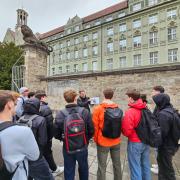
The Xinjiang province in China is an area that has been plagued by ethnic tension and violence in the past. It is now home to several of China’s newly erected concentration camps. Why has China deemed these concentration camps necessary and what goes on inside them?
The Xinjiang province is a territory located in the north-west of China. Xinjiang is home to many ethnic minorities including a population of Uighurs. Uighurs are ethnically Turkic Muslims who have strong ties to central Asia. In the past decade, Xinjiang has been the place of several violent incidents thought to be caused by ethnic tensions between these ethnic minorities and the dominant Han Chinese. China blames this unrest on Islamic extremism. China has responded by enlisting a hundred thousand new police officers, creating checkpoints where Uighurs are stopped and searched, and detaining one million people in camps. The US Defence Department has called them concentration camps. The U.N has called them “massive interment camps that are shrouded in secrecy”. China simply calls them re-education centres.
China claims that the purpose of the camps are to help individuals who have been affected by ‘extremist thoughts’. They insist the people they have detained are not prisoners but students who are there of their own volition. The real purpose of the camps is both shallow and sinister. Because the proportion of Uighurs to Han Chinese used to be so high in Xinjiang, Uighurs have managed to have their own independent nation 2 separate times in Xinjiang. Although both independent nations crumbled, China is still terrified of loosing control over this territory again. Xinjiang accounts for 40% of China’s coal reserves, 20% of their oil and gas, and 20% of their wind energy. Due to Xinjiang being located in the north-west of China, it is also a pathway to many other countries and opportunities. When the ‘Belt and Road’ initiative was launched by China (a trillion-dollar investment for things like fibre optic cable, trainlines and gas pipelines) they found that many of the routes pass through Xinjiang. In fear that the province would be taken over and separated from China by the Uighur population again, the government started to act.
China’s goal for these camps is to remove Uighur culture to promote ‘unity’ in everyday society. In these camps, Muslims are forced to abandon their religion; they are not permitted to pray on the premises – an area which they are not allowed to leave – and are forced to study Mandarin, learn China’s restrictions on religion and replace their loyalty to their religion with loyalty to China’s communist party. Despite China denying that the people in these ‘re-education centres’ are prisoners, the people there are made to wear uniforms so they can be easily identified and are confined as 10 to a room with only one toilet. Many other horror stories of people being shackled, beaten and even killed have been told but with China preventing journalists from reporting freely there is no proof of these stories yet. What we do know for certain is anyone China deems as ‘extremist’ is sent to these camps and that seems to include anyone who identifies as Muslim; some have been arrested for simply studying Arabic or the Qur’an. People can spend months or years in these camps and some never leave at all.
Unfortunately, with China becoming an ever-growing global super power, there is little faith that anything will be done to stop them. China makes almost half of the worlds goods and has been nicknamed the “factory of Asia”. Many countries have also fallen into China’s debt trap which means that if a conflict were to occur, they would struggle to repay debts back to China immediately. Because of these factors, countries are afraid to act. This is a time to stand united against islamophobia and persecution; if we do not stop them now, who are we to call ourselves humanitarian.
By Amelie H


























